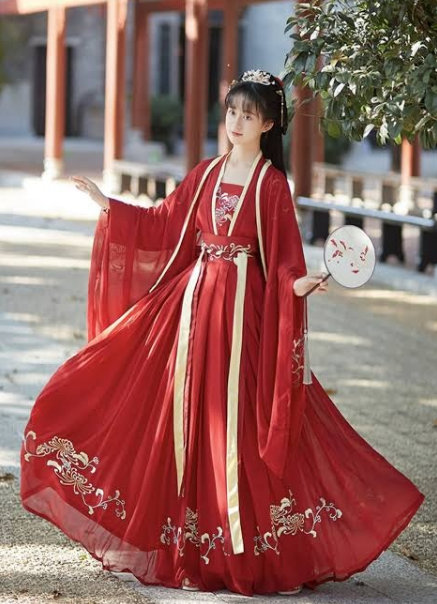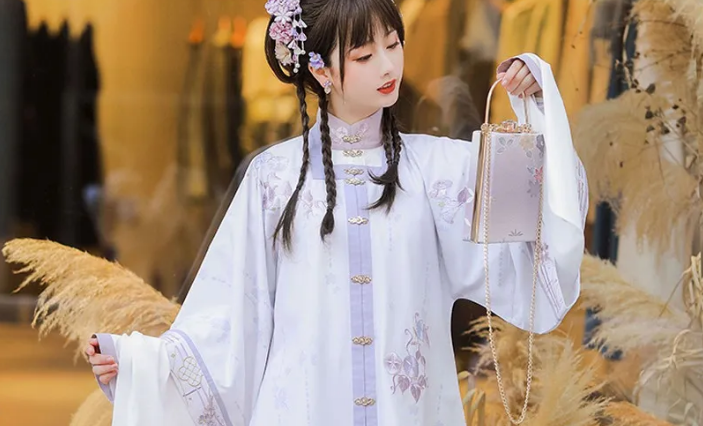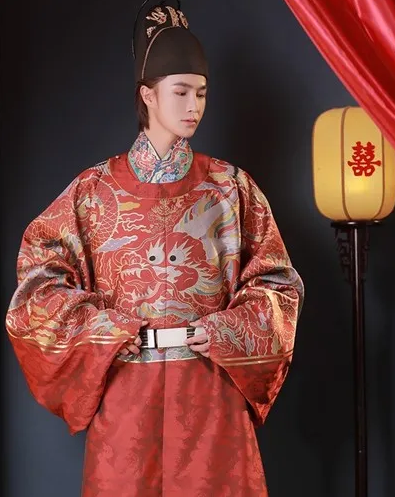Historical Evolution of Hanfu
Hanfu, the traditional clothing of the Han Chinese people, embodies a rich cultural heritage spanning over three millennia. This clothing style, with its aesthetic and philosophical nuances, illustrates the evolution of Chinese society, politics, and art.
Origins and Early Development
Hanfu traces its roots to the earliest days of Chinese civilization. Legends often attribute its origin to such mythological figures as the Yellow Emperor and the Emperor Yao. In reality, archeological findings, such as those from the Shang and Zhou dynasties, provide tangible evidence of Hanfu’s early style. This period saw the emergence of basic Hanfu elements like the “yi” (a narrow-cuffed, knee-length tunic tied with a sash) and the “shang” (a skirt worn with the yi). The elegance and simplicity of these early designs reflect the philosophical tenets of harmony and balance, integral to Chinese culture.

Influence of Various Dynasties
Each Chinese dynasty significantly influenced Hanfu, refining and redefining its aesthetics and symbolism.
- Zhou Dynasty: The Zhou Dynasty formalized the Hanfu system, linking clothing colors and designs to social hierarchies. This era emphasized Confucian ideals, which later became foundational in the Hanfu aesthetic.
- Han Dynasty: The Han Dynasty, from which “Hanfu” derives its name, played a pivotal role. This period saw the consolidation of Hanfu styles, featuring the cross-collared robe (Ruqun), which became a cultural icon.
- Tang Dynasty: The Tang Dynasty ushered in a golden age of cultural openness. Hanfu evolved with influences from along the Silk Road, exemplified by vibrant colors and broader silhouettes, showcasing the cosmopolitan nature of Tang society.
- Song and Ming Dynasties: These periods are known for refining Hanfu, focusing on modesty and understated elegance. The Ming Dynasty, in particular, standardized Hanfu styles, which are often what contemporary reconstructions are based on.
This progression of Hanfu through the dynasties not only mirrors the changing tastes and aesthetics of the times but also reflects the underlying shifts in social, political, and philosophical thoughts. Each era’s unique contribution to Hanfu’s design is a testament to the enduring and dynamic nature of Chinese culture.
Classification and Components of Hanfu
Hanfu, as a historical and cultural symbol, possesses a complex system of classification and components, each embodying different aspects of ancient Chinese society. Understanding these elements is crucial to appreciating the Hanfu’s cultural and aesthetic significance.
Basic Styles and Patterns
The Hanfu ensemble typically consists of several key components, each style having its own historical and cultural significance:
- Yi (衣): This is the top or tunic part of Hanfu. Its styles can vary from the simple, crossed-collar “Shenyi” (深衣) to the more intricate “Panling Lanshan” (盘领襕衫), characterized by its patchwork pattern and lapel design.
- Chang (裳): Chang refers to the skirt or lower garment part. The styles range from the pleated skirts of the Tang dynasty to the more straight-cut versions in the Ming.
- Pao (袍): The Pao is a type of robe or coat, often worn for more formal occasions. Distinct styles like the “Daxiushan” (大袖衫) with its wide sleeves, showcase the grandeur of traditional Chinese fashion.
- Pei (配): Accessories are vital in Hanfu. This includes sashes, belts, hats, and jewelry, each adding to the garment’s elegance and symbolism. For instance, the “Bianfang” (边方), a square-shaped silk scarf, often symbolizes a person’s social status.
Ritual versus Everyday Wear
The distinction between ritual and everyday wear in Hanfu reflects not only fashion choices but also social customs and norms:
- Ritual Wear: This category includes garments specifically designed for ceremonies and official functions. Often more elaborate, these outfits adhere to strict Confucian dress codes. Examples include the “Chaofu” (朝服), worn at court, or the “Jifu” (祭服), used for religious or ancestral rites.
- Everyday Wear: For daily life, the Hanfu was simpler and more practical, focusing on comfort and ease of movement. Everyday outfits, such as the “Ruqun” or the “Zhiju” (直裾, a straight-hemmed robe), were common, reflecting the wearer’s daily activities and social occasions.
Through its intricate styles and varied uses, Hanfu provides a vivid window into the life, culture, and values of ancient China, highlighting the deep connection between clothing, identity, and tradition in Chinese history.
Ritual Dress Systems in Ancient China
The ritual dress systems in ancient China, deeply rooted in the country’s philosophical and religious traditions, played a crucial role in the ceremonial and social life. These systems, rich in symbolism and hierarchy, were not just about clothing but were also reflections of societal order and cosmic principles.
Confucian Influence on Ceremonial Attire
Confucianism, with its emphasis on ritual and propriety, profoundly influenced the Chinese ritual dress system. Key Confucian concepts, such as order, hierarchy, and respect for tradition, directly shaped ceremonial attire:
- Hierarchy and Color: Confucianism dictated strict dress codes based on social status, rank, and occasion. The use of colors in garments, particularly in court attire, followed specific rules. Emperors typically wore bright yellow, symbolizing the center of the universe, while officials and scholars wore shades based on their ranks and roles (Chinese court dress).
- Robes and Hats: Confucian rituals required different types of robes and specific headgear, such as the “Guan” (冠, a type of formal hat) and “Mianfu” (冕服, a ceremonial robe), worn during court ceremonies and state rituals. These garments symbolized the wearer’s dignity and respect for the ceremonial process.
Comparison with Daoist and Buddhist Dress Systems
While Confucianism focused on social hierarchy and order, Daoist and Buddhist dress systems presented a contrast, emphasizing spiritual ideals and detachment from worldly matters:
- Daoist Attire: Daoist priests and followers often wore loose, simple robes symbolizing their pursuit of harmony with nature and detachment from societal conventions. Colors like blue and green, representing the Daoist affinity with nature, were prevalent in their attire (Daoist robe).
- Buddhist Robes: Buddhist monastic clothing, known as “Jiasha” (袈裟), was typically modest and made from patched cloth, reflecting the Buddhist values of simplicity, humility, and renunciation. The colors often ranged from yellow to grey, varying among different schools and traditions.
These different dress systems in ancient China highlight the interplay between clothing, philosophy, religion, and social order. They provide a fascinating lens through which to view the rich tapestry of Chinese culture and history.

Symbolism and Philosophy in Hanfu
The Hanfu, more than just traditional attire, encapsulates deep layers of symbolism and philosophy. Each aspect, from the colors and patterns to the cut and drape, conveys meanings and reflects the rich cultural heritage and ethical values of ancient China.
Color, Patterns, and Their Meanings
In Hanfu, colors and patterns are not mere aesthetic choices; they carry significant symbolic weight and communicate social, philosophical, and even political messages:
- Colors: Traditionally, five primary colors (Wu Xing colors) – blue (木, wood), red (火, fire), yellow (土, earth), white (金, metal), and black (水, water) – dominate Hanfu designs. Each color corresponds to a natural element and a set of attributes. For instance, yellow, often used by emperors, represents earth, centrality, and supreme power in the Chinese color symbolism system.
- Patterns: The motifs and patterns in Hanfu, such as dragons, phoenixes, and clouds, have specific connotations. Dragons, primarily associated with the emperor, symbolize power and authority. Phoenixes often represent grace and virtue, particularly linked to the empress or noble women. Other common motifs like lotuses, bamboo, and plum blossoms signify purity, integrity, and resilience, respectively.
Philosophical Concepts Embodied in Garments
Hanfu is not just clothing; it’s a manifestation of the philosophical ideas that have shaped Chinese thought:
- Confucianism: The strict hierarchy and formality of Hanfu styles reflect Confucian ideals of social order and propriety. The emphasis on symmetry in Hanfu resonates with Confucian teachings on balance and harmony.
- Taoism (Daoism): The flowing, loose-fitting nature of many Hanfu garments, especially those worn by Taoist adherents and scholars, mirrors Taoist principles of simplicity, naturalness, and going with the flow of the Tao (Tao Te Ching).
- Buddhism: While not directly influencing Hanfu styles, Buddhist philosophy of detachment from materialism and earthly desires is often contrasted with the more ornate and hierarchical elements in traditional Hanfu, presenting an interesting dichotomy in Chinese cultural and religious apparel practices.
Hanfu, therefore, is more than mere attire. It’s a rich, living tapestry of colors, patterns, and designs, each thread infused with the philosophical and cultural essence of ancient China, offering insights into the Chinese way of life, belief, and aesthetics.
Hanfu in Imperial Ceremonies and State Rituals
Hanfu, in the context of imperial ceremonies and state rituals, was more than just clothing; it was an integral part of the ceremonial fabric of Imperial China, symbolizing order, hierarchy, and the divine right of the rulers. These garments were meticulously designed to convey power, dignity, and the Confucian-based imperial ideology.
Dress Codes in Imperial Courts
In the imperial courts, Hanfu dress codes were stringent and reflective of one’s status and role within the hierarchy:
- Emperor’s Attire: The emperor’s ceremonial robes, often in imperial yellow and adorned with dragon motifs, embodied supreme authority and celestial mandate. The most formal of these was the “Dragon Robe” (Longpao), richly embroidered and a symbol of imperial power and dignity.
- Court Officials’ Garments: The attire of court officials was less ornate but still followed strict guidelines. Colors, designs, and the number of embroidered mythical animals (like cranes or turtles) on their robes indicated their rank and status. The “Mianfu” of court officials, used in the most formal ceremonies, often featured a distinctive crane motif, symbolizing longevity and high status.
Hanfu in Religious and State Functions
Hanfu in religious and state functions served to bridge the mortal and spiritual worlds, embodying the ritualistic and philosophical ethos of the time:
- State Rituals: During important state rituals like the Heaven Worship ceremony, the emperor and his officials wore specific Hanfu that symbolized communication with the heavens and the solemnity of the occasion. The “Chaofu” was typically reserved for such events, emphasizing the gravity and sacredness of these rituals.
- Religious Ceremonies: For religious and ancestral rites, Hanfu styles varied depending on the specific ritual’s nature and requirements. The “Jifu”, a ritual garment, was often used, especially in Confucian ceremonies paying homage to ancestors, reflecting the deep-rooted respect for filial piety and tradition in Chinese culture.
In these contexts, Hanfu was much more than mere dress. It was a crucial element in the pageantry of imperial and religious ceremonies, symbolizing the cosmic and social order central to traditional Chinese culture and governance.
Revival and Modern Interpretation of Hanfu
The revival and modern interpretation of Hanfu reflect a growing interest in traditional Chinese culture, particularly among the youth. This resurgence is not just a fashion trend; it’s a movement towards cultural identity and heritage appreciation, blending ancient aesthetics with contemporary fashion sensibilities.
Hanfu Movement in the 21st Century
The Hanfu movement, gaining momentum in the 21st century, especially with the support of social media and increased national pride, focuses on resurrecting traditional Han Chinese clothing styles that were largely replaced after the Qing Dynasty:
- Cultural Renaissance: The movement is part of a larger cultural renaissance, with young people exploring their heritage through clothing. It’s fueled by a desire to reconnect with and redefine Chinese identity, countering years of cultural erosion.
- Community and Events: Across China and beyond, Hanfu enthusiasts gather at festivals, events, and in online communities, sharing styling tips, historical knowledge, and celebrating traditional festivals in Hanfu. This camaraderie and shared interest have brought traditional Chinese attire back into public consciousness.
Contemporary Design and Cultural Identity
Modern Hanfu designs adapt ancient styles for contemporary life, blending traditional patterns, colors, and fabrics with modern fashion elements:
- Fashion Fusion: Today’s Hanfu designers often experiment with fabric, cut, and ornamentation, merging traditional Hanfu elements with modern fashion trends. This fusion makes Hanfu more wearable in daily life while still retaining its symbolic and aesthetic heritage.
- Symbol of Identity: For many, wearing Hanfu is a statement of cultural identity and pride. It’s a way to showcase China’s rich history and artistic heritage in a world where East meets West. This aspect has made Hanfu relevant not only as a historical costume but as a living, evolving part of Chinese culture.
The revival and reinterpretation of Hanfu go beyond mere nostalgia. They are expressions of a dynamic, evolving cultural identity, reflecting the enduring appeal and relevance of China’s sartorial legacy in the modern world.








